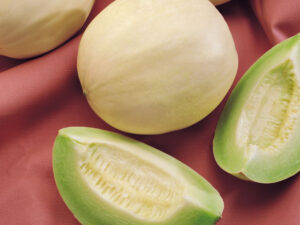
Transplanting ‘Honey Pac’ melons, a variety known for its sweet flavor and typically honeydew-like characteristics, in open land settings involves several key steps to ensure healthy growth and optimal fruit development. Here’s a structured guide:
Transplanting ‘Honey Pac’ Melon in Open Land
1. Transplanting
- Choose a location with full sun exposure and well-drained, fertile soil. Melons thrive in warm conditions.
- Space the plants about 90-120 cm apart in rows that are 1.5-2 meters apart. This spacing is crucial for proper vine growth and air circulation.
- Water the plants thoroughly after transplanting to help establish them in their new environment.
2. Land Management
- Regularly maintain soil moisture, particularly during fruit set and growth phases. Avoid overwatering, as this can lead to root diseases.
- Use mulch around the plants to help retain moisture, control weeds, and maintain stable soil temperatures.
- Black plastic mulch can also be used to warm the soil and accelerate growth, especially in cooler climates.
3. Pest and Disease Control
- Monitor for common melon pests such as aphids, cucumber beetles, and melon worms, and use appropriate control methods.
- Practice crop rotation and maintain good field hygiene to reduce the risk of soil-borne diseases.
- Keep an eye out for fungal diseases, which are common in melon cultivation, and act promptly if detected.
4. Harvesting
- ‘Honey Pac’ melons are typically ready for harvest when they exhibit signs of maturity like a change in color, a sweet aroma, and a slight softening at the blossom end.
- Harvest the melons by cutting the stem close to the fruit, leaving a small portion of the stem attached.
Best Method for Cultivating ‘Honey Pac’ Melon
Open Land Cultivation is generally the most suitable method for ‘Honey Pac’ melons, due to the following reasons:
- Space for Vine Growth: Open land provides ample space for the sprawling vines of melon plants, which is essential for their growth and fruit development.
- Natural Growing Conditions: This method takes advantage of natural sunlight and facilitates pollination, which are critical for melon cultivation.
- Effective Water and Nutrient Management: Managing water and nutrients is often more straightforward in open land settings compared to controlled environments like hydroponics.
- Disease and Pest Management: The natural environment can help mitigate certain pests and diseases through better air circulation.
- Cost-Effectiveness: Generally, open land cultivation requires a lower initial investment and operational costs compared to hydroponic or aquaponic systems.
It’s important to consider local environmental conditions, including climate, soil type, and water availability, when choosing the cultivation method. In regions where land or water is scarce, or precision agriculture is preferred, alternative methods like hydroponics might be more suitable.





Reviews
There are no reviews yet.